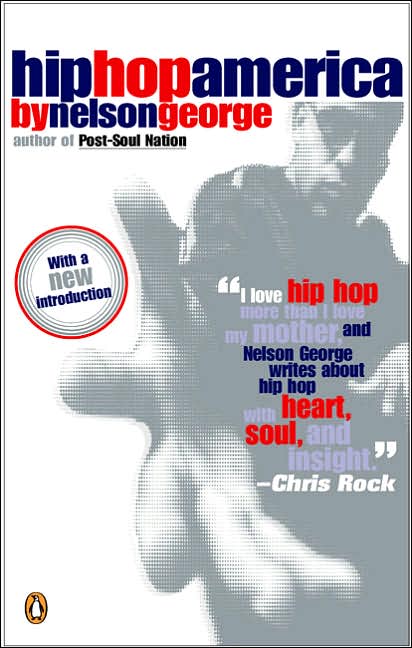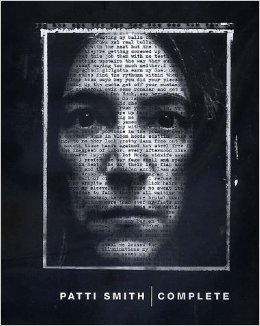Last Fall, Charles Aaron wrote, “What the White Boy Means When He Says Yo” for the pierceder-than-thou Spin, The piece was an excellent exploration of the role hip hop plays in the lives of white teenagers today, and not surprisingly, Aaron found some contradictory attitudes. On one hand, their affection for the music and the culture it represents is positive, but too often their identification with rappers as rebels has racist undercurrents.
 Rap, along with punk, made 1977 a watershed year because these two musical forms were born then, and they have changed the world’s cultural landscape. Today, hip hop’s influence is more obvious than punk’s, so understanding hip hop’s origins and significance is crucial to understanding end-of-the century America. Nelson George, one of America’s leading writers on what he calls “post-soul,” examines the national scene in Hip Hop America. The book is not a consumer guide, nor is it exactly a history, but it will enlighten those trying to make sense of not just hip hop music, but modern African-American culture.
Rap, along with punk, made 1977 a watershed year because these two musical forms were born then, and they have changed the world’s cultural landscape. Today, hip hop’s influence is more obvious than punk’s, so understanding hip hop’s origins and significance is crucial to understanding end-of-the century America. Nelson George, one of America’s leading writers on what he calls “post-soul,” examines the national scene in Hip Hop America. The book is not a consumer guide, nor is it exactly a history, but it will enlighten those trying to make sense of not just hip hop music, but modern African-American culture.
George is probably known for The Death of Rhythm and Blues, an important provocative book that shows the paradoxical experience of black music in America. As the music became bigger, it became more and more attractive to the music industry. The more industry was involved, the more the music and culture moved from what made it so appealing in the first place. Think of Stax Records versus R. Kelly or Ernie K. Doe on the radio versus any disc jockey today and George’s point is made. George tells this story with a newspaper journalist’s directness, a characteristic missing from Hip Hop America. In his new book, George pulls at the different ends of the hip hop Gordian Knot to see how each strand affects the whole. About a third of the way through the book, readers may wonder impatiently if the bits and pieces are ever going to add up to anything, but once they settle into his rhythm the style makes a lot of sense.
Hip hop culture, after all, is complicated, and a simple history really doesn’t address the questions people want answered. More than wanting to know who did what, people want to know why guys wear their pants so low on their hips, who or what a “Fubu” is, and if gangstas really are “keepin’ it real.” George answers the last question in one of Hip Hop America’s more compelling chapters. He writes, “Not all rappers who write violent lyrics have lived the words. Most exercise the same artistic license to write violent tales as do the makers of Hollywood flicks.” He doesn’t dismiss gangstas as fake because some rappers had a gangsta background, and because violent lyrics are often “a natural consequence of a world where a sixteen-year old is shot at close range over his jacket by classmates;” instead, he puts the image in the context of other storytellers, in which case gangsta stories are part of the “wide range of narrative strategies.” The gangsta image, he shows, is a very complex one.
As a writer, George walks a difficult line. The most common ways to write about contemporary rap are in sensational headlines, sociological jargon, or rap slang, all of which alienate some part of his readership. George’ brings a working journalist’s common sense to his writing, treating the events that caused headlines and tendencies that rev sociologists’ motors with equal matter-of-factness, and only using slang when it really is the most effective way to express a thought.
He discusses contemporary hip hop with an ease than may stem from the music being a central part of his adult life. He came of age as a writer as rap was developing, and in Hip Hop America, he quotes from the first piece he wrote for Billboard in 1978. Throughout the book, his personal reflections are a part of the story, and while his involvement may make him seem biased, it also lets the reader know that rap is more than just George’s favorite subject matter; it is an important part of his life. It doesn’t take long for readers to realize that George is a critic they can trust.
Hip Hop America is not, however, a lapdog of a book. George is not afraid to suggest some controversial possibilities, the most interesting being the homoerotic dimension of gangsta bonding. Neither is he afraid to tell the stories many would prefer remain untold. He writes about Lisa Williamson, the activist Chuck D. of Public Enemy renamed Sister Souljah, and shows how far she actually was from the figure then-governor Bill Clinton attacked in a 1992 speech.
In the chapter tellingly titled, “Capitalist Tool,” he discusses rap’s changing style and the embrace of labels like Tommy Hilfiger, reminding readers how tricky the relationship between art and commerce can be. Ultimately, Nelson George gives readers a lot to think about and a number of possibilities to consider, and as rap, hip hop beats and sampling become more and more a part of the contemporary musical vocabulary, not knowing where these things come from and what baggage they carry is at best narrow-minded.
Rap and punk shared a D.I.Y. —”Do It Yourself”— aesthetic. Part of the premise of both musics was that anyone could make music, and that “musical competence” was relative. When Patti Smith’s second album, Radio Ethiopia, was released, one critic called it “four chord… not well played,” Village Voice critic Robert Christgau answered, “If they were executed with the precise attack of an Aerosmith, then they would not be well played.” Patti Smith was a punk as surely as John Lydon and Grandmaster Flash, and like them, she did her small part to change the world. In Complete: Lyrics, Reflections & Notes for the Future, Smith’s influence can be seen.
C omplete is an art book. It is beautifully presented, has wonderful photos, many by the late Robert Mapplethorpe, and it presents Smith’s writing for her albums as poems. Not all of the lyrics work as poems, but a surprising number do. The pieces written for Radio Ethiopia, which she says followed an intense writer’s block, particularly merit a reread or two.
omplete is an art book. It is beautifully presented, has wonderful photos, many by the late Robert Mapplethorpe, and it presents Smith’s writing for her albums as poems. Not all of the lyrics work as poems, but a surprising number do. The pieces written for Radio Ethiopia, which she says followed an intense writer’s block, particularly merit a reread or two.
The pieces in the book, however, inevitably lead back to Smith, so it’s hard to read them and not think about her’ as a writer. It’s also hard not to think about the music when reading these pieces, and consider what prompted the changes. As she moved from record to record, her lyrics became more spare and more song-y, as if she developed more and more confidence in her ability to write tight, precise lines and to convey their full meanings with just her voice. In short, the unique presence of Patti Smith invites readers to think about these pieces and the stories they really tell.
If nothing else, Complete should make listeners want to visit or revisit Patti Smith’s records. She was and remains an “art hero,” as Christgau named her, and it can be argued that her records made artistic aspiration possible in the post-punk era.
Her courage is on every page of Complete in lines that dared critics to dub her pretentious but by taking those chances, and surviving, she made it easier for bands like Nirvana, R.E.M. and Smashing Pumpkins to sing about something besides going to the party on a Friday night. She showed that rock ‘n’ roll is a form, loud guitars are tools, and that the best artists can make those things say something remarkable all by themselves.




